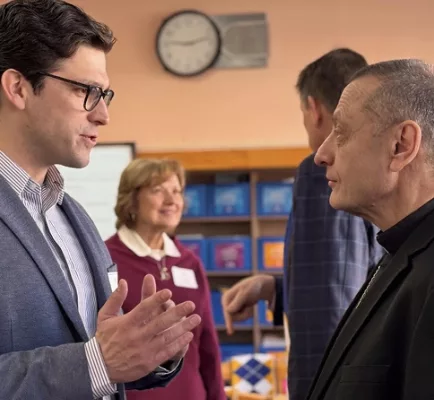
At St. Ann Academy, two Connecticut legislators joined local educators and clergy to discuss the Catholic Academy of Bridgeport’s role in a state where the quality of education can vary dramatically by geography. Senators Ryan Fazio (R—Greenwich) and Tony Hwang (R—Fairfield) led a session that explored strategies to expand resources for parochial schools. The discussion ranged from tax incentives for scholarships to broader policy questions about the sustainability of school choice as a lever for addressing inequities in public education.
Senator Fazio framed the issue in terms of opportunity: “A student’s zip code should not determine their destiny. Parochial schools like the Catholic Academy of Bridgeport provide hope and opportunity to kids and families who deserve it but might otherwise not have it.” His comments echoed long-standing concerns about how Connecticut’s achievement gap—among the widest in the nation—limits upward mobility for many students.
The Catholic Academy, which serves nearly 900 students, stands out for its robust offerings. Executive Director Angela Pohlen described a range of programs designed to give students experiences beyond the classroom, from STEM and arts initiatives to outdoor science experiments on Long Island Sound. These opportunities, she argued, are essential for developing the whole child, particularly for families who may not have access to similar enrichment elsewhere.
Still, the academy’s ability to provide these resources depends heavily on private funding. “Non-public schools get very little money from the state,” said John Kennedy, a board member, who advocated for SB 122, a bill that would create tax credits for scholarship donations. The proposal, while aimed at increasing financial support for schools like the Catholic Academy, underscores the reliance of such institutions on philanthropy rather than public investment.
Senator Hwang pointed to parochial schools as a potential model for innovation in education, citing their ability to maintain academic rigor while fostering extracurricular engagement. “The continued development and support of our parochial schools mirrors what is necessary to support our public schools,” Hwang said. But he also emphasized the need for systemic investment, noting that technological and pedagogical advancements must be scaled to benefit all students, regardless of the type of school they attend.
Bishop Frank Caggiano, a vocal advocate for Catholic education, highlighted the importance of partnerships between parochial and public schools. “Our goal is to help all our children to grow in wisdom and grace to unlock their gifts and talents,” he said. His vision, though compelling, raises a critical question: can collaboration bridge the structural divides that often leave public schools underfunded while parochial schools remain dependent on unpredictable streams of private donations?
This dual challenge—unequal funding for public schools and the tenuous financial footing of many private institutions—reflects deeper systemic issues. Schools like the Catholic Academy of Bridgeport serve as a reminder of what’s possible when resources align with need. Yet their existence also highlights how much remains unresolved in a state that prides itself on its educational reputation.
Senator Fazio’s legislative proposals, such as tax credits for scholarships, offer a pragmatic starting point. But they do little to address the root causes of inequality, such as the state’s reliance on property taxes to fund public education, which entrenches disparities along socioeconomic lines.
For now, the Catholic Academy continues to navigate this complex landscape, balancing ambition with pragmatism. Its leaders and advocates remain optimistic, even as the policy solutions available to them seem incremental at best. As Bishop Caggiano noted, “Together, we can ensure all our children have the resources they need to thrive.” Whether those resources will be sufficient—and equitably distributed—remains an open question.


